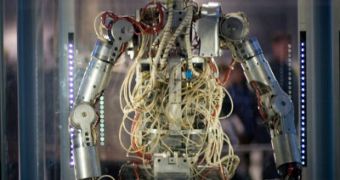One of the main objectives in the robotics industry today is for the research community to develop a method of making robots able to switch their gait depending on the terrain ahead. While this comes absolutely natural to humans, it is extremely difficult to implement in artificial machines. Up until now, robots have been reduced to selecting the appropriate gait only after analyzing the terrain in front of them, and have failed to do so continuously, as they were walking.
But German researchers at the Max Planck Institute for Dynamics and Self-Organization, in Gottingen, say that they have now discovered a new way of achieving this elusive goal. They explain that, in the human brain, periodically reoccurring activities such as breathing and walking are controlled by a dedicated host of neural pathways, called “central pattern generators” (CPG). Up until now, in robotics, researchers have stuck to using a single CPG for a single gait inside robots. In this approach, the machine stops to assess its surroundings once in a while, and then selects the best possible gait.
At its time, this was an impressive achievement. Robots understand that they are climbing or descending on a slope, and they adjust their gaits accordingly, thanks to a host of sensors on their outside, which control the flow of impulses to the central processing unit. One of the primary functions of the CPG is to generate the so-called “chaos control.” However, when left unchecked, it engages in chaotic activity patterns. What the German team determined was in fact that the impulses sent by the external sensors on the robot could easily control these chaotic activities, and turn them into periodic, reoccurring ones.
For tasks such as climbing walls, a six-legged robot would, for example, need to know where it started from, so as to ensure that all of its feet take the appropriate actions. “Currently, the robot would not be able to handle this task – as soon as the obstacle is out of sight, it no longer knows which gait to use. Once the robot is equipped with a motor memory, it will be capable to use foresight and plan its movements,” Max Planck researcher Marc Timme explains.

 14 DAY TRIAL //
14 DAY TRIAL //